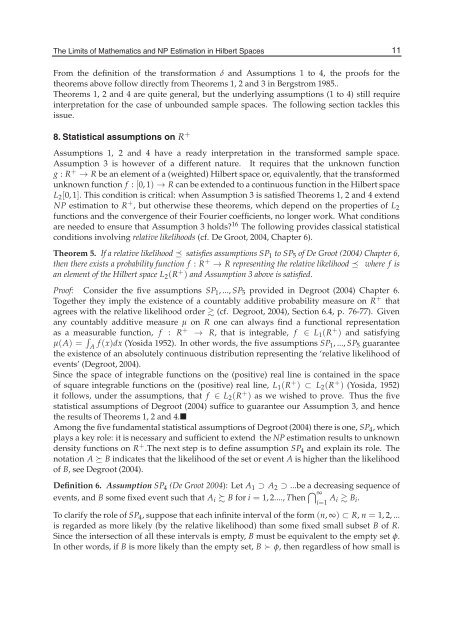The Limits of Mathematics and NP Estimation in ... - Chichilnisky
The Limits of Mathematics and NP Estimation in ... - Chichilnisky
The Limits of Mathematics and NP Estimation in ... - Chichilnisky
- No tags were found...
Create successful ePaper yourself
Turn your PDF publications into a flip-book with our unique Google optimized e-Paper software.
<strong>The</strong> <strong>Limits</strong> <strong>of</strong> <strong>Mathematics</strong><strong>and</strong> <strong>NP</strong> <strong>Estimation</strong> <strong>in</strong> Hilbert Spaces 9<strong>The</strong> <strong>Limits</strong> <strong>of</strong> <strong>Mathematics</strong> <strong>and</strong> <strong>NP</strong> <strong>Estimation</strong> <strong>in</strong> Hilbert Spaces11From the def<strong>in</strong>ition <strong>of</strong> the transformation δ <strong>and</strong> Assumptions 1 to 4, the pro<strong>of</strong>s for thetheorems above follow directly from <strong>The</strong>orems 1, 2 <strong>and</strong> 3 <strong>in</strong> Bergstrom 1985..<strong>The</strong>orems 1, 2 <strong>and</strong> 4 are quite general, but the underly<strong>in</strong>g assumptions (1 to 4) still require<strong>in</strong>terpretation for the case <strong>of</strong> unbounded sample spaces. <strong>The</strong> follow<strong>in</strong>g section tackles thisissue.8. Statistical assumptions on R +Assumptions 1, 2 <strong>and</strong> 4 have a ready <strong>in</strong>terpretation <strong>in</strong> the transformed sample space.Assumption 3 is however <strong>of</strong> a different nature. It requires that the unknown functiong : R + → R be an element <strong>of</strong> a (weighted) Hilbert space or, equivalently, that the transformedunknown function f : [0, 1) → R can be extended to a cont<strong>in</strong>uous function <strong>in</strong> the Hilbert spaceL 2 [0, 1]. This condition is critical: when Assumption 3 is satisfied <strong>The</strong>orems 1, 2 <strong>and</strong> 4 extend<strong>NP</strong> estimation to R + , but otherwise these theorems, which depend on the properties <strong>of</strong> L 2functions <strong>and</strong> the convergence <strong>of</strong> their Fourier coefficients, no longer work. What conditionsare needed to ensure that Assumption 3 holds? 16 <strong>The</strong> follow<strong>in</strong>g provides classical statisticalconditions <strong>in</strong>volv<strong>in</strong>g relative likelihoods (cf. De Groot, 2004, Chapter 6).<strong>The</strong>orem 5. If a relative likelihood ≼ satisfies assumptions SP 1 to SP 5 <strong>of</strong> De Groot (2004) Chapter 6,then there exists a probability function f : R + → R represent<strong>in</strong>g the relative likelihood ≼ where f isan element <strong>of</strong> the Hilbert space L 2 (R + ) <strong>and</strong> Assumption 3 above is satisfied.Pro<strong>of</strong>: Consider the five assumptions SP 1 , ..., SP 5 provided <strong>in</strong> Degroot (2004) Chapter 6.Together they imply the existence <strong>of</strong> a countably additive probability measure on R + thatagrees with the relative likelihood order (cf. Degroot, 2004), Section 6.4, p. 76-77). Givenany countably additive measure μ on R one can always f<strong>in</strong>d a functional representationas a measurable function, f : R + → R, thatis<strong>in</strong>tegrable, f ∈ L 1 (R + ) <strong>and</strong> satisfy<strong>in</strong>gμ(A) = ∫ A f (x)dx (Yosida 1952). In other words, the five assumptions SP 1, ..., SP 5 guaranteethe existence <strong>of</strong> an absolutely cont<strong>in</strong>uous distribution represent<strong>in</strong>g the ‘relative likelihood <strong>of</strong>events’ (Degroot, 2004).S<strong>in</strong>ce the space <strong>of</strong> <strong>in</strong>tegrable functions on the (positive) real l<strong>in</strong>e is conta<strong>in</strong>ed <strong>in</strong> the space<strong>of</strong> square <strong>in</strong>tegrable functions on the (positive) real l<strong>in</strong>e, L 1 (R + ) ⊂ L 2 (R + ) (Yosida, 1952)it follows, under the assumptions, that f ∈ L 2 (R + ) as we wished to prove. Thus the fivestatistical assumptions <strong>of</strong> Degroot (2004) suffice to guarantee our Assumption 3, <strong>and</strong> hencetheresults<strong>of</strong><strong>The</strong>orems1,2<strong>and</strong>4.Among the five fundamental statistical assumptions <strong>of</strong> Degroot (2004) there is one, SP 4 ,whichplays a key role: it is necessary <strong>and</strong> sufficient to extend the <strong>NP</strong> estimation results to unknowndensity functions on R + .<strong>The</strong> next step is to def<strong>in</strong>e assumption SP 4 <strong>and</strong> expla<strong>in</strong> its role. <strong>The</strong>notation A ≽ B <strong>in</strong>dicates that the likelihood <strong>of</strong> the set or event A is higher than the likelihood<strong>of</strong> B, see Degroot (2004).Def<strong>in</strong>ition 6. Assumption SP 4 (De Groot 2004): Let A 1 ⊃ A 2 ⊃ ...be a decreas<strong>in</strong>g sequence <strong>of</strong>events, <strong>and</strong> B some fixed event such that A i B for i = 1, 2...., <strong>The</strong>n ⋂ ∞i=1 A i B i .To clarify the role <strong>of</strong> SP 4 , suppose that each <strong>in</strong>f<strong>in</strong>ite <strong>in</strong>terval <strong>of</strong> the form (n, ∞) ⊂ R, n = 1, 2, ...is regarded as more likely (by the relative likelihood) than some fixed small subset B <strong>of</strong> R.S<strong>in</strong>ce the <strong>in</strong>tersection <strong>of</strong> all these <strong>in</strong>tervals is empty, B must be equivalent to the empty set φ.In other words, if B is more likely than the empty set, B ≻ φ, then regardless <strong>of</strong> how small is








